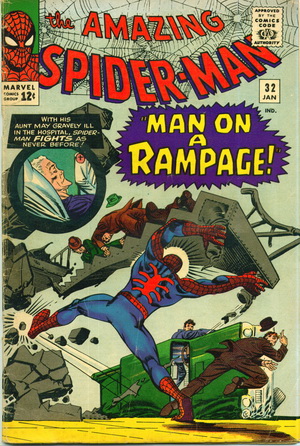
Published: January, 1966
Script: Stan Lee
Plot: Steve Ditko
Art: Steve Ditko
Letters: Artie Simek
In last month’s issue of The Amazing Spider-Man, the mysterious Master Planner gave a great deal of attention to designing all kinds of difficulties for our costumed hero. The writers gave a great deal of attention to keeping secret the true identity of the Master Planner—most probably so it could be revealed in dramatic fashion when Marvel Comics and its readers were next scheduled to meet again, right here in issue #32.
To set the stage: in his under the sea hidden headquarters, as the Master Planner continues to plan ways to thwart his mortal enemy, the Amazing Spider-Man, he also revels in his belief that no one yet knows his true identity. But all that is about to change! Almost immediately, before the reader can even get to the middle of page two, we get this:
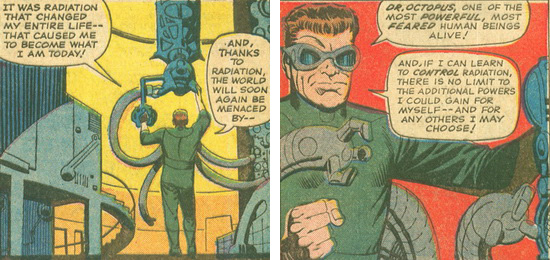
So! Here we find out the Master Planner is, in fact, Dr. Octopus, whom we met ages ago in issue #3. (Doc Ock, by the way, is back courtesy of the notoriously inadequate prison system of these early Marvel Comics. But that’s a whole ’nother story…)
Not very long after this, Spidey is let in on the secret as well, and when he and Doc Ock first see each other, Ock celebrates the occasion by letting out a hearty, hokey, “So Spider-Man—we meet again!”
Ka-boom!
I love this moment. I’ve often heard some version of “So we meet again!” spoofed in popular culture, most often in over-the-top comedies about larger-than-life heroes and villains, but I’m not sure I’ve come upon these words uttered with such clarity in an actual comic book.
The moment is so, so satisfying.
Very often in the real world, unlike in comics, “meeting again” is an enjoyable, fun, heartfelt experience. We reunite with old friends or relatives, remember a long-lost love, reconnect with activities from our younger days that once again provide a great deal of pleasure. The “pleasure” Doc Ock expresses in his exclamation of “So, Spider-Man…we meet again!” might be somewhat perverse—as all super-villains are, by definition, perverse—but still, it is a pleasure to him, all the same.
Coming back to something familiar after a long absence is often a pleasure. Case in point: This blog is now eleven years old. Much to my amazement, I have been reading and writing about Marvel Comics for eleven years. Wow. How did that happen so fast? Of course, to be fair, I should lessen that number by three, since there was a “dark period” from 2016 to 2019 when I didn’t blog, and I don’t remember actually reading any comics during that time, either. In fact, there’s a lot about that time I don’t remember…or at least, would rather forget. During this difficult period in my life, priorities were skewed, and a lot of fun activities simply had to shut down.
But I made it through. Wiser, better (I hope). And in a way, as life slowly returned to “normal,” I guess you could say I eventually experienced my own personal “So!…We meet again!” as many enjoyable aspects of my life slowly returned…including Marvel Comics.
Seeing Doc Ock immortalize those words in print brought my mind around to the pleasure that was revived when I finally got back to Marvel Comics after such a long absence. I have other stories (not all involving Marvel Comics, of course) and I’ll relate another one later in this post, but right now, let’s get back to our Spidey story.
As it turns out, Doc Ock is not the only character making an encore performance. This particular Amazing Spider-Man issue is chockful of so-we-meet-again moments.
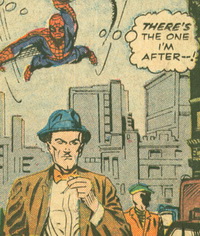 Let’s start with the easiest one: Although Foswell was in fact the gang boss knows as the Big Man (ASM 10), after going legit, he got his job back at the Bugle and posed as “Patch,” who was an informant. The fact that the writers are pulling from so many past stories serves as a reminder of how rich a history they have already established in only 32 issues. Where might they go next?
Let’s start with the easiest one: Although Foswell was in fact the gang boss knows as the Big Man (ASM 10), after going legit, he got his job back at the Bugle and posed as “Patch,” who was an informant. The fact that the writers are pulling from so many past stories serves as a reminder of how rich a history they have already established in only 32 issues. Where might they go next?
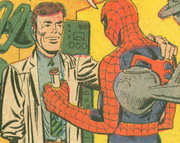 Events being what they are, Spidey also decides to look up his old friend Dr. Connors, who in issue #6 was the villain the Lizard. Remember him? Previously, Spider-Man helped Dr. Connors overcome his reptilian affliction, and now the man is willing to do whatever he can, to help Spider-Man in return. It’s good to have friends in positions of power, with useful knowledge. Especially when one of your arch-enemies from long ago is interfering with your plans to get a healing potion to your poor sick dying aunt.
Events being what they are, Spidey also decides to look up his old friend Dr. Connors, who in issue #6 was the villain the Lizard. Remember him? Previously, Spider-Man helped Dr. Connors overcome his reptilian affliction, and now the man is willing to do whatever he can, to help Spider-Man in return. It’s good to have friends in positions of power, with useful knowledge. Especially when one of your arch-enemies from long ago is interfering with your plans to get a healing potion to your poor sick dying aunt.
BAD BLOOD
Yes, poor Aunt May is sick. Again. Actually, she’s been sick off and on most of the time we’ve known her, but what can you expect from someone who’s drawn as if she’s 120 years old? Despite what her previous ailments may have been, at this point her doctors have determined that her condition is caused by radioactivity in her blood.
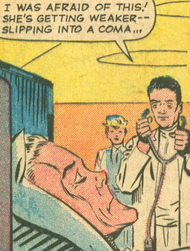 Really? How did that happen? Going back again to issue #10, as Aunt May was having a different medical issue, Peter donated his blood. At first he was reluctant, concerned the radioactivity from his fateful spider bite could be passed on to Aunt May, but he breathed a sigh of relief when the medical professionals informed him his blood was perfectly okay. Well, guess what? They were wrong. And now Aunt May is at death’s door, and once again, as when Uncle Ben died, Peter is involved, and torn up with guilt.
Really? How did that happen? Going back again to issue #10, as Aunt May was having a different medical issue, Peter donated his blood. At first he was reluctant, concerned the radioactivity from his fateful spider bite could be passed on to Aunt May, but he breathed a sigh of relief when the medical professionals informed him his blood was perfectly okay. Well, guess what? They were wrong. And now Aunt May is at death’s door, and once again, as when Uncle Ben died, Peter is involved, and torn up with guilt.
As much as I hate all these horrible things that are happening to poor Peter, I also love it (not in a perverse way, though, I assure you). None of the Marvel titles I’m reading have ever been as simple as “Good guy fights bad guy, good guy wins, The End,” but these multiple efforts to dig deep into the rich history of this title show an impressive level of sophisticated storytelling. The sudden appearance of both a nearly-forgotten villain, quickly followed by an equally nearly-forgotten ally, hits the reader like a lightning bolt. Pretty soon, Marvel won’t even have to bother making up new villains and heroes; they can just keep pulling from their already ample stable of characters.
Now, here’s my second personal “So!…We meet again!” story. In 2003, I took my kids to see The Pirates of the Caribbean. Fun times, to be sure! One of my favorite characters from the film was Captain Barbossa, as entertaining as he was evil. (Also, I am a longtime fan of Geoffrey Rush. If you keep reading my blog long enough, you’ll soon become convinced there are very few actors who aren’t on my “Ooh! I like him!” list.) So it was more than a little disappointing when Barbossa was shot dead by Jack Sparrow at the end of the first film.
 Or…was he?? In the next installment…there he is again, in all his swaggering glory, making a surprise appearance in the very last scene. GASP!! Could it be?? And I do mean “Gasp!” I distinctly remember gasping and grabbing my daughter’s arm when Barbossa appeared. Did anyone else see that coming? Or, twenty years ago, was I not yet as savvy a filmgoer as I am now? Twenty years ago, I had next to nil exposure to the world of comics, so I was probably not aware of a lot of story strategies for these epic types of adventures with larger-than-life characters. I had not yet heard the saying “If you don’t see the body, they’re not dead.” (Russ likes to add, “If you DO see the body, they’re still not dead!”) So the idea of characters coming “back from the dead” was not something I generally considered as a possibility.
Or…was he?? In the next installment…there he is again, in all his swaggering glory, making a surprise appearance in the very last scene. GASP!! Could it be?? And I do mean “Gasp!” I distinctly remember gasping and grabbing my daughter’s arm when Barbossa appeared. Did anyone else see that coming? Or, twenty years ago, was I not yet as savvy a filmgoer as I am now? Twenty years ago, I had next to nil exposure to the world of comics, so I was probably not aware of a lot of story strategies for these epic types of adventures with larger-than-life characters. I had not yet heard the saying “If you don’t see the body, they’re not dead.” (Russ likes to add, “If you DO see the body, they’re still not dead!”) So the idea of characters coming “back from the dead” was not something I generally considered as a possibility.
But in the world of comics, and in the world of entertainment in general (if you’re paying attention…) anything can happen. And usually does. My point is, it’s always fun to be surprised. In comics, I mean. And entertainment. But not always so much in real life. I prefer my drama to be literary, not literal. (See my earlier recounting of my “dark years.”)
POOR PETER
So, there are some things about comic book stories that perhaps cannot be anticipated, but on the other side of this equation, there are other things upon which we can steadily rely. In The Amazing Spider-Man series, it’s this:
Poor Peter. Can I ever get through my thoughts about this title without at some point lamenting “Poor Peter”? Nothing goes right for this kid. Every story seems to contain at least some of the many stresses that unrelentingly plague our hapless hero. Not only is there no relief from all his girl troubles, money troubles, bully troubles, villain troubles, ailing aunt, and having to deal with a blowhard of a boss, but as time goes on, each of these concerns grows only more intense.
For poor Peter’s sake, I would like to inject a note of hope. If I had to guess, I would say Aunt May does eventually receive her dose of the healing ISO-36 and gets better. And STAYS better. Of course, since she appears an appropriate online date for Ingmar Bergman’s Death figure from The Seventh Seal,  we probably can’t depend upon her being around indefinitely. And unfortunately (and again I’m only guessing), but when Aunt May finally dies, it seems likely Spider-Man will somehow be involved, and poor Peter will once again be racked with guilt.
we probably can’t depend upon her being around indefinitely. And unfortunately (and again I’m only guessing), but when Aunt May finally dies, it seems likely Spider-Man will somehow be involved, and poor Peter will once again be racked with guilt.
But I hope the writers grant him at least a short reprieve during which he can feel his beloved elder relative is doing as well as possible.
Before we can get to anything approximating an at least partially happy ending, Spidey must first overcome the cliffhanger at the end of issue #32. We leave him trapped under enormous beams that have fallen from the ceiling, unable to reach the life-saving isotope…upon which a steady drip, drip, drip is threatening to flood the entire room. And even if he can get out from under the beams and secure the ISO-36 before the room is flooded, he will then have to fight his way through a legion of the Master Planner’s minions. And even if he can get past this small army, the clock is ticking as the serum is losing potency: will Spider-Man be able to deliver it to Dr. Connors in time for him to get it to Aunt May and save her life? OMG! How will this ever turn out?
For the answer to these and other alarming questions, I guess we’ll have to wait until next issue, when…we meet again…
| Want to read this comic on your computer? Marvel has a scan! Want to own the story? Buy the Masterworks! |















The whole Master Planner trilogy is really just a terrific example of what made early Marvel so successful. The struggles and pathos Peter’s dealing with, both in and out of costume, gives the battling much greater stakes than there often seem to be. Good stuff.
As for your noting the phrase, “If you don’t see the body, they’re not dead,” I prefer the slight variant attributed to the Bene Gesserit in the _Dune_ series:
“Do not count a human dead until you’ve seen his body. And even then you can make a mistake.”
I would imagine there are multiple versions of “If you don’t see the body, they’re not dead.” I am not familiar with the Dune series, though of course I’ve heard a lot about it over the years. At some point I will have to tune in and see what everybody is raving about! 🙂
The first book is a masterpiece. The second one … isn’t, but it’s also a ton shorter, and the third one is (IMO) pretty close to the level of the first. There are more after that, but the core trilogy is probably sufficient unless you get ridiculously into it.
If you’re “tuning in” to a more visual approach, the two Denis Villeneuve movies of the past few years are terrific. The David Lynch one in 1984 is an atrocity, despite a fairly good cast.
Thanks for the advice about Dune. Since the first book is so long, and I already have so many books on my To-Read list, I’m opting to add the 2021 movie to my To-Watch list instead.
I was talking with Russ about the book, and he said the entire planet’s civilization is supported by the cultivation and export of a “spice.” I’m wondering if you get the idea that this “spice” is actually a drug? Not that it matters, but it’s difficult to believe any single spice could be so delicious and/or beneficial that an entire planet’s economy would hinge on it!
The term “spice” is not used in the nutritional sense, definitely. It has certain druglike characteristics, definitely, but I don’t think describing it as “a drug” is quite accurate either. More than that might go into spoiler territory.
On a different note, the first novel is often described as one of the first works of ecological SF. It’s got huge amounts of world-building.